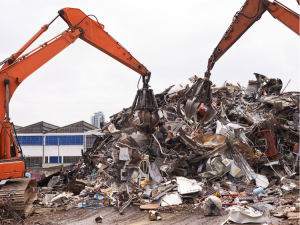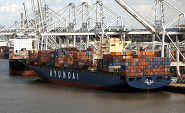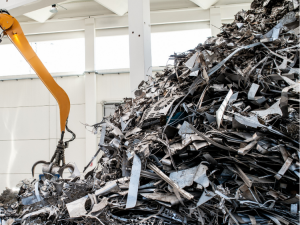
Export scrap market weak so far in April
The ferrous scrap export market has been thinly traded thus far in April in the Atlantic Basin.


The ferrous scrap export market has been thinly traded thus far in April in the Atlantic Basin.

There are several other tariffs implications concerning the ferrous raw materials sector. In addition to tariffs on DRI/HBI imports, there will be also be a tariff on raw materials imported to domestically based metallics producers.

The price spread between hot-rolled coil (HRC) and prime scrap narrowed in April after widening since January, according to SMU’s most recent pricing data.

US scrap prices declined in April for all the grades tracked by SMU amid tariff uncertainty, according to market sources.

The imposition of reciprocal tariffs by President Trump as explained on Wednesday afternoon has rattled virtually every market. This policy has some advantages for the steelmaking sector, but there may be some disadvantages that were not considered, especially for the EAF producers of flat-rolled.

Last week, much attention was focused on President Trump’s “Liberation Day” tariffs and rightly so. They have thrown a big wrench into the market-reading business. Whether you are for them or against them, the potential outcomes are hazy, at best. Maybe we should not forget the basics, tariffs concerns notwithstanding. The basics of this ferrous […]

The price of pig iron for the US market remains firm despite a potential drop in domestic ferrous scrap prices going into April.

The US ferrous scrap market rise this year is showing signs of slowing down as US steelmakers adjust production in line with slower automotive production and sales. But President Trump's announcement of 25% auto tariffs could change things very fast.

The export situation from the US East Coast was interrupted last week after a political event in Turkey.

The US scrap market is in for another unpredictable ride going into April. Questionable scrap flows, extended winter weather, and implications of tariffs on steel and scrap continue to have an impact.

The HRC vs. prime scrap spread increased again in March.

The US Trade Representative (USTR) has drafted a proposal targeting the Chinese shipbuilding industry by setting elevated port fees for any maritime shipping company associated with Chinese-built vessels.

“The next months are going to be good ones for pig iron producers," according to one source.

After an unusually long period of waiting for the March scrap market settlements, several mills are now actively buying ferrous scrap. And it looks like prices are ticking up.

Domestic shredded scrap has experienced a renaissance in pricing since January. And that increase had caused traditional exporters to ship their material to domestic users instead of overseas. But with recent changes, this cycle may end with the resurgence of export demand and continued foreign exchange fluctuations.

The situation on ferrous scrap has cleared up with the pause of the implementation of Canadian and Mexican blanket tariffs.

We really don’t know yet what and how severe the impact will be. But we do know ferrous scrap will become more expensive in the US. And it will be less expensive for Canadian mills. The larger consequences will be felt on the Canadian front. Even so, in the Southwest, the tariffs on Mexico will lower prices for Mexican scrap and might limit normal flows across the border.

The main impact of tariffs on scrap prices would be felt in Northern states - and especially among those along the Canadian border. Many steelmakers in this area receive a substantial portion of their monthly scrap charge from Canadian processors. Much of it is prime scrap used by hot-rolled (HR) coil producers.

As February comes to a close this week, the scrap markets are poised for another – and perhaps more extreme – move upward in March. March is usually a month when scrap prices relent as winter’s impediments subside. That’s not the case this year. And this time, the driver of prices will be increased demand from mills along with restricted flows over the last two months.

SMU's Stephen Miller provides an update on the raw materials sector.

An update on the US scrap export market.

There has been considerable upward movement in the US prices paid for future shipment of Brazilian-produced pig iron over the last week.

The ferrous scrap market in the US and Canada is trying to find its way through difficulties that could well determine its direction over the next several months.

The price spread between hot-rolled coil (HRC) and prime scrap widened in February ahead of the implementation of President Trump’s tariffs on steel.

A comparison of the current cost of pig iron vs. busheling scrap.

The reprieve for Canadian and Mexican tariffs this week has left some uncertainty for the February scrap market, with some sources pointing towards a $20-per-gross-ton (gt) increase.

The scrap and metallics market has reacted to the tariffs potentially being implemented on our neighbors to the north and south. These could have a serious impact on the market, especially on Canada, unless these products are exempted.

The US scrap market sentiment has become more bullish over the last week. Many districts are telling SMU that the potential rise in prices will exceed the earlier estimate of $20 per gross ton (gt). Several sources have pegged the February market as up $30-50/gt. Here are several regional viewpoints from the trade: In the […]

Nucor’s raw material segment generated an annual profit of $57 million in 2024. This marked a swing to profit over 2023 when Nucor reported a $14-million loss for the segment. The Charlotte, N.C.-based company did not say in their earnings call on Tuesday what caused this increase besides a 20% increase in the production and […]

There is no doubt pig iron will be needed to fuel the expansion of flat-roll capacity in the US and Canada. Where will it come from? How much will it cost? What will be the quality? Is it a good business to produce merchant pig iron? The US imports between 4-6 million metric tons (mt) per year of […]